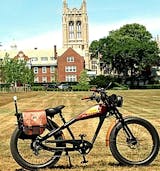
Factors Influencing Electric Bike Range
The range of your electric bike refers to the distance you can ride on a single charge. Assessing the range of an electric bike can be difficult, as it varies from person to person. All electric bikes are advertised as having a particular range, but these advertised ranges are usually inaccurate and some can be quite exaggerated. In extreme cases, advertised ranges could even be four times higher than the realistic range. It's nearly impossible for electric bike range claims to be completely accurate because so many factors depend on the individual rider and the riding conditions.
- How much the rider weighs
- The level of pedal-assist the rider chooses
- The riding terrain
- Amount of luggage being towed
- Speed of the ride — a 1/3 faster speed will result in 1/2 the range
- How many times the bike is stopped and started — hill starts, in particular, will drain power
- Wind conditions
- Temperature — on a warm, sunny day, a battery will get about 15% more range than a battery on a cold, winter day
- Tire pressure — just like in traditional bikes, soft tires will be less efficient and will result in less distance for power expended
- The size and age of the battery
- Motor size — while bigger motors are more fun, they will drain more battery power
- Speed
How to Determine Electric Bike Range
While most people want to have the most powerful bike motor they can afford, it's important to note that motor power only impacts how fast you can pull off and how well you can get up hills. Motor power does not necessarily impact how far you can go. When it comes to electric bike range, the most important variable to consider is the battery capacity.
Battery capacity is usually measured in Watt-hours (Wh), where Watt-hours= amp-hours x volts. The Watt-hours calculation is important because it determines the range of your electric bike, or how far you can go.
Example:
1. Bike A has a 24V - 20Ah battery: 24V x 20Ah = 480Wh
2. Bike B has a 48V - 10Ah battery: 48V x10Ah = 480Wh
3. Bike C has a 24V - 6Ah battery: 24V x 6Ah = 144Wh
Bikes A and B have a similar amount of energy. If Bike A and Bike B have equal motors and riders, they will perform in a very similar fashion. The bike with the higher voltage battery will accelerate faster and climb better — but that will be at the expense of some of that energy. On the other hand, Bike C will not take you nearly as far.
Simply put, if you want an eBike that accelerates fast, climbs well, and can travel long distances on a single charge, then you should purchase one with a battery that has high voltage and high amp-hours. A battery with high voltage and low amp-hours will shorten the distance you can travel on a single charge.
It's important to also consider the issue of range with regard to the type of motor you are buying. For example, there is a good argument that mid-drive motors get a better range than hub drive motors because they work synergistically with the gears.
NOTE: When you are looking at adverts for electric bikes, you may find some advertisements where the battery capacity is simply stated in amp-hours. This is an insufficient way to advertise range, as it does not include the voltage and does not accurately reflect the true energy capacity of the battery. If a bike is advertised with a 36V battery and a capacity of 9 amp-hours, then the true capacity of the battery is 324 watt-hours (9x36=324).







Leave a comment